ADFK Blogs
Action Economy

Author’s Note: In b4 “um actually!”, while I call this blog Action Economy, and use a lot of fancy analogies and high-tech graphics, I also understand that what I’m talking about is a mix of game balance and action economy, not purely an action economy assessment. This isn’t supposed to be a definitive guide or anything scientific, it is just my thoughts that I wanted to put in writing, and to hopefully explain why you hear me yelling and screaming when I look at some of the PvP skill trees workhorse has been dropping. Hopefully it helps some people, but I know for many experienced gamers it will not be anything new. Regardless, if you have any complaints, please send them to @Franz_0x on twitter.
Before getting too into the strategy part of this I have to start out with why I love strategy games, in this case specifically turn based games. If there is one thing I cannot stand in video games (and games in general) it’s losing. And in my opinion, the worst way to lose is not by being outsmarted, succumbing to your opponent’s better strategy, no, it’s losing because your opponent was simply faster/quicker with their controls or moves. You did everything right, you picked the right strategy, but your opponent was simply faster. It’s the worst, most prevalent here is first person shooters. You could have the fanciest gun, best armor, but if your opponent sees you on the map and shots you first, you lose. The WORST. However, I'm sure I wasn’t the first clumsy, slow nerd to think this, as turn based strategy games (and other strategy based games) have eliminated this "quickest on the trigger" wins style. While yes, it eliminates that "fast action pace" of a first-person shooter, turn based games force players to win by using their best strategies.
Turn based strategy games have some key components that make the game, in my opinion, an equal playing field, throwing the concept of "fastest" out the window. It truly becomes a battle of wits. The way this equality is created is by starting the two opposing sides off with the exact same starting resources. Then both sides of the battle get equal turns to perform certain actions. Back and forth until a winner is determined. Both players have the same number of heroes, with same access* to abilities, stats, and levels. While details are still to be determined, I'm sure both sides will be able to bring in the same number of items.
I want to note here, while on paper all the heroes and classes are "equal" each have ability trees that are unique. This is one reason why Wowee and I go on such long conversations about the individual moves of the skill trees, because as you will see, creating value, having something unique that other classes do not have, could be the difference in a matchup against an opponent that has nearly the exact same set up as you do. So even 1 ability from 1 hero being different could be a huge advantage.
Back to the equal resources concept of the game. At the start of every battle there are two sides: yours and your opponents. I like to envision it on a scale. On both sides we have a few key things, heroes, their hit points, their mana points, and items. Specifically for the heroes, they have their turns**, as this is a 3v3, each side gets 3 turns. This equilibrium, you can sort of think of an "economy" at the start the economy is all equal.
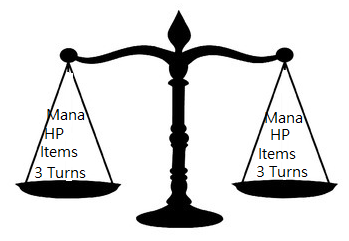
As you can see in the very high-tech graphic, at the start of the battle, you and your opponent have equal resources. And while certain classes might have more HP or Mana than others, we can trust that the game creators have ensured that those differences are made up in other places so that having higher HP will not tip those scales too far in either direction. And if it wasn’t evident, if you eliminate a hero by killing them, then your opponent only has “2 turns” and the scales will weigh heavily in your favor.
So now that the "economy" is established, you need to decide what "actions" you are going to take and how they effect that economy. Ideally, you want every action you take to push the economy (the scales) in your favor, until it is unbearable for your opponent and you win.
This is how I approach most strategy games, thinking of these different aspects of the game as resources. This does not mean everyone should do it, nor does it even mean I am "right" however for me, when I am assessing what strategy I use in a turn-based game, I think, will this tip the scales in my favor? If a move does damage to my opponent, but requires my hero to use his turn, does the loss of hit points that the opponent hero losses, tip the scales enough that my loss of a turn keeps them relatively balanced.
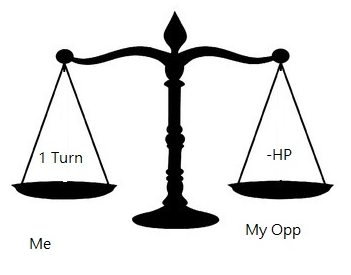
Are the scales going to favor me if I do this move? Now there isn't a concrete answer to that and once the actual game is out, we will have to assess what kind of hit point damage a basic attack does. If the move has a mana cost that adds to this equation, not only am I losing my turn, I am losing another one of my resources, mana. If that's the case I would very much hope the opponent is losing a significant amount of HPs.
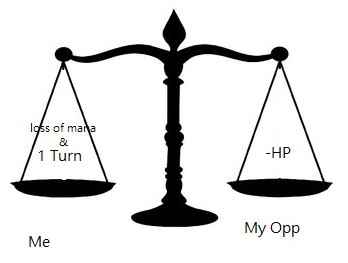
In this scenario, I'm losing a decent number of resources so that HP loss better be worth it. Otherwise, my opponent will get a slight advantage on those scales, as the weight of losing my turn and mana will be heavier than whatever HP they lost (or maybe lighter? It’s just an analogy not a real scale).
A great example of “tipping the scales” can be seen in the elite generic trait “Stun”. This move is almost always going to return you value, as it cuts down an entire turn for the opponents’ side of the scale. Not only that, it deals some damage to their HP. For the cost of using a turn, you take away an opponent’s turn, and deal some damage to their hero. And if timed right in the turn order, could make the next round be 3 turns on your side, to 2 turns on theirs. A HUGE swing in the scales.
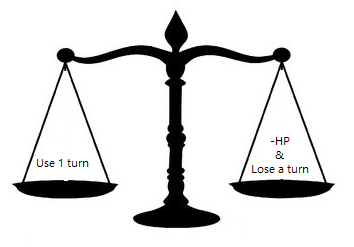
This is also one reason why myself and Wowee "lost our mind" (Seer Release) when we saw some of the seer hero abilities. One of the most efficient ways to gain action economy advantage is to increase your number of resources so that the initial “equilibrium” the game creates is tipped in your favor. Several of the seer moves give you such advantages, one example is “Time Warp" a 10-cost skill move seen below:

Going back to the formula, this move looks like the following:
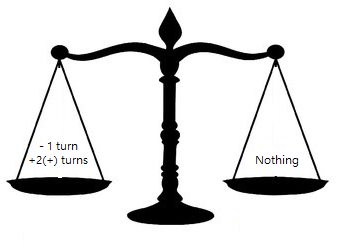
If this was done at the start of the battle, that 3 turns on your scale becomes 4 turns. Meanwhile your opponent is still sitting there with 3 turns, like a chump. Not only this but the seer ability states multiple turns are gained, god help this game if its more than 2 because the seer would become an unstoppable force at that point. (The scales would break if you had 5 turns to your opponents' 3.)
Finally, this then leads me to a point I (and wowee, and stycks intern, and bob nothing, and many others,) have been saying for some time now, passive abilities are VERY STRONG. Going back to the scales, for vast majority of passive abilities, there is NO COST TO YOU for them to occur. Compared to the turn you have to use for a damage dealing move.

With passive abilities the economy is being tipped in your favor without ANY actions having to be "spent" by your team. Passives have massive advantages, and could push those scales in your favor in battle.
This is just a basic overview of action economy, I’m not the first to write about it, nor am I the best, so please DYOR and THIS IS NOT FINANCIAL ADVICE.
Bullish
- Matty
*Access to equal heroes: while the heroes facing off my not be the same levels, the opportunity for each player to have equal levels are the same. (I can hear the small wallets complaining here and yes, whales will have an advantage, but there is simply no way to avoid whales have bigger wallets and more heroes.)
**The team has been playing around with terms like "rounds, turns, and duration”, but for this article I am going to call them turns and keep it simple. Each round, all heroes get 1 turn, so in a 3v3, 6 turns total.
[Feb. 10, 2023]